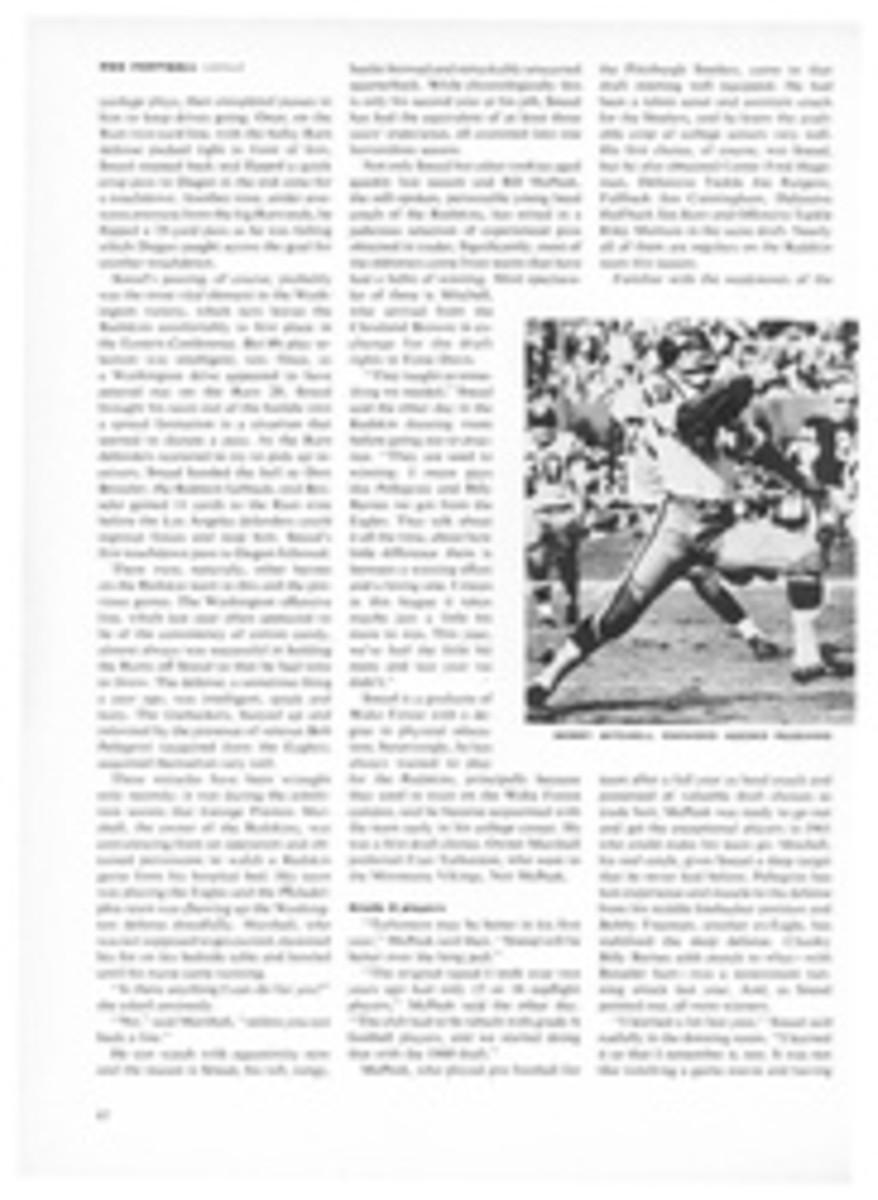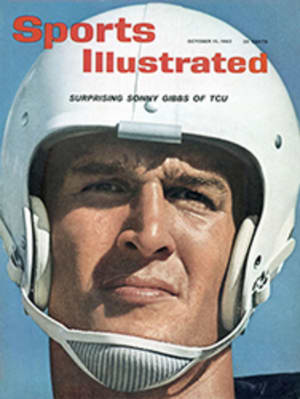
19TH HOLE: THE READERS TAKE OVER
BROWN'S TEN
Sirs:
As an ardent Southwest Conference supporter, I was all set to dismiss Gwilyim Brown (Another Big Year in the Big Ten, Oct. 1) as just another Midwest sportswriter trying to prove an unprovable point. Then the scores of Nebraska-Michigan (25-13), Stanford-Michigan State (16-13) and Missouri-Minnesota (0-0) came in, and I could just see Mr. Brown wincing.
Southwest fans feel that the only true measure of Big Ten-Southwest strength lies in the results when they play each other (which, regrettably, is all too seldom—Ohio State would draw huge crowds in Dallas, Houston, Austin or Waco). One local sports-writer, after a scan of the records, states that since the Big Ten and SWC first met, the Big Ten has claimed 14 wins and the Southwest 13, with two ties. If that is overwhelming superiority—I'm confused.
GORDON GRAHAM
San Antonio
Sirs:
Why doesn't Ohio State stop beating around the bush and play someone with a national ranking? Even in their own conference they could play Michigan State every year instead of avoiding the really tough teams.
They could come down and play Texas every year and probably get sent back to their Big Ten country thoroughly thrashed. They should have to beat the six conference teams they play by more than 20 points to get on any rating sheet.
DICK SIM
El Paso
Sirs:
The Stanford-Michigan State game not only bolstered the AAWU's position of authority, but embarrassed the Big Ten far more than Purdue's tying Washington proved its (the Big Ten's) strength. Stanford will have to hustle to be in the upper division of the Big Six, but the Spartans are second only to Ohio State in the Big Ten.
JIM DOWLING
Seattle
LAST ASTERISK
Sirs:
Well, the ill-fated New York Mets have finally lost more games than any other major league team has before, but I don't think, in all fairness to the Mets, that it is a record. In your Aug. 13 issue it was stated that in 1916 the Philadelphia Athletics lost 117 games (Worst Baseball Team Ever). This was when the major leagues were playing a 154-game schedule. But let me point out that at the end of the Mets" 154th game they had lost only 116 games, one shy of the Philadelphia mark. Casey Stengel's unfortunate Mets didn't lose their 117th game until they played their 156th.
JOHN STEEPY
Geneva, N.Y.
IT WASN'T HAY
Sirs:
I thought that you might be interested in this picture (see below) of the 1,500-pound sturgeon taken from the Snake River in 1911, which Joe David Brown mentioned in his article (The Monster Fish of American Rivers, Sept. 17).
Even Bessie Buhl, the mare that I am holding in the picture, was astonished at the size of the beast. By the way, Bessie only weighed 750 pounds. The baby that my mother is holding seems to be much more interested in fine livestock than big fish.
Alex Grant brought in three sturgeon that hot July day. One was a couple of feet shorter than the one in the picture, the last was a baby of about 200 pounds. Weighing the fish on my father's hay scales while the whole family gathered around was an easy matter. I swear, a load of hay going to the loft never pulled as hard as that fish.
Alex caught his fish below the Owsley Bridge in the upper Salmon Falls Rapids, just a few miles east of Hagerman, in the Snake River. He used an eel for bait, with about a seven-inch hook attached to -inch cord.
ERNIE BYRNE
Santa Ana, Calif.
SERIES SECRET
Sirs:
I have read with much amusement The Big Golf Secret (Sept. 24) and, for what this is worth, I would like to express a few comments that the writers missed in favor of splitting the winner's money.
First, in baseball a pitcher can walk a batter intentionally. It is permitted as a matter of strategy.
Second, it's an old maxim in Wall Street, "Don't put your eggs all in one basket." Well, the golf pros have a perfect right to play it safe, too. So I see no harm but a lot of good coming out of a deal where the money is split. It is, after all, a business venture, just like other professional sports.
GEORGE F. CRONMILLER JR.
Pittsburgh
Sirs:
Let us just imagine that in the World Series (of baseball) each team has won three games. After nine innings of the seventh game, the teams are tied. The opposing managers get their heads together and agree to split the player pot evenly among all concerned. What is likely to be the reaction of those rabid baseball fans who sit in the stands (or remain glued to their television sets) to watch their favorite team fight to a spectacular victory when they learn later that the contest had been settled at the end of nine innings?
HERSCHELL LAMNEY
Indianapolis
THE OL' CANARY HIDE
Sirs:
The cover of your October 1 issue showing red, white and blue baseballs is quite interesting. In fact, it gave me an idea.
For years we have heard ballplayers complain about the sea of white shirts, as seen from the batter's box, making it difficult to see the ball and at times causing the batter to be hit by a pitched ball.
What would be wrong with a brightly colored baseball? For example, yellow, which could probably be seen better than any other color.
No need to tell me that the pitchers would not go for this idea, but I would like to know the thinking along these lines.
GEORGE SHABAY
Graham, Texas
•The yellow baseball has already made its mark in the major league game; in fact, it was enshrined in the Hall of Fame. The idea was first introduced in 1938 by Frederic H. Rahr, president of a New York marketing research and color consulting firm, who developed a special minus-blue yellow which, by absorbing the blue of the sky and the ground, would enable the batter—and the fans—to see the entire circumference of the ball. "The result," says Rahr, "was that the ball looked bigger to the batter and appeared to move slower. The eye could follow the ball through its complete trajectory on a high fly." With the blessing of Larry MacPhail, then vice-president of the Brooklyn Dodgers, and Commissioner Landis, Rahr's yellow ball was put to the test in a double-header between the St. Louis Cardinals and the Brooklyn Dodgers at Ebbets Field.
The general reaction to the experiment was favorable—except for Brooklyn Pitcher Fred Fitzsimmons. He had yellow dye up to his elbows. "Pitchers were afraid of it because there was more hitting," Rahr admits, "but there was also better fielding. Fans were delighted." Following further experiments in Chicago and St. Louis, Spalding contracted to produce yellow balls and the National League officially accepted the yellow sphere—on the condition that managers specifically requested it. They never did.—ED.
ROOKIE THREATS
Sirs:
The comment in BASEBALL'S WEEK (Oct. I): "Chicago came up with a nice new outfield...Danny Murphy (six straight hits), Billy Ott (his homer helped beat the Cardinals) and Nelson Mathews (his grand slam beat the Dodgers)" set me thinking. To wit:
At the end of the season, it is the practice of major league teams, especially those out of it all, to bring up promising rookie hopefuls for a look-see. This is a great idea—for the rookies. However, I question the fairness of this practice to others concerned. It seems fair enough for the also-rans to try out rookies when playing against fellow also-rans. They are just finishing the season like the schedule says, anyhow. But is it fair for rookie hopefuls (such as Murphy, Ott and Mathews) to demolish the Dodgers, who were having a tough time trying to win the pennant anyhow, or to beat the Cardinals who, at the time a rookie's homer beat them, had a chance mathematically, if not practically, to latch on to some World Series money?
I say no. When an also-ran plays a contending club it should go with the players it failed with all year.
J. LOWELL HAYS
Bellefontaine, Ohio
PHOTO

